|
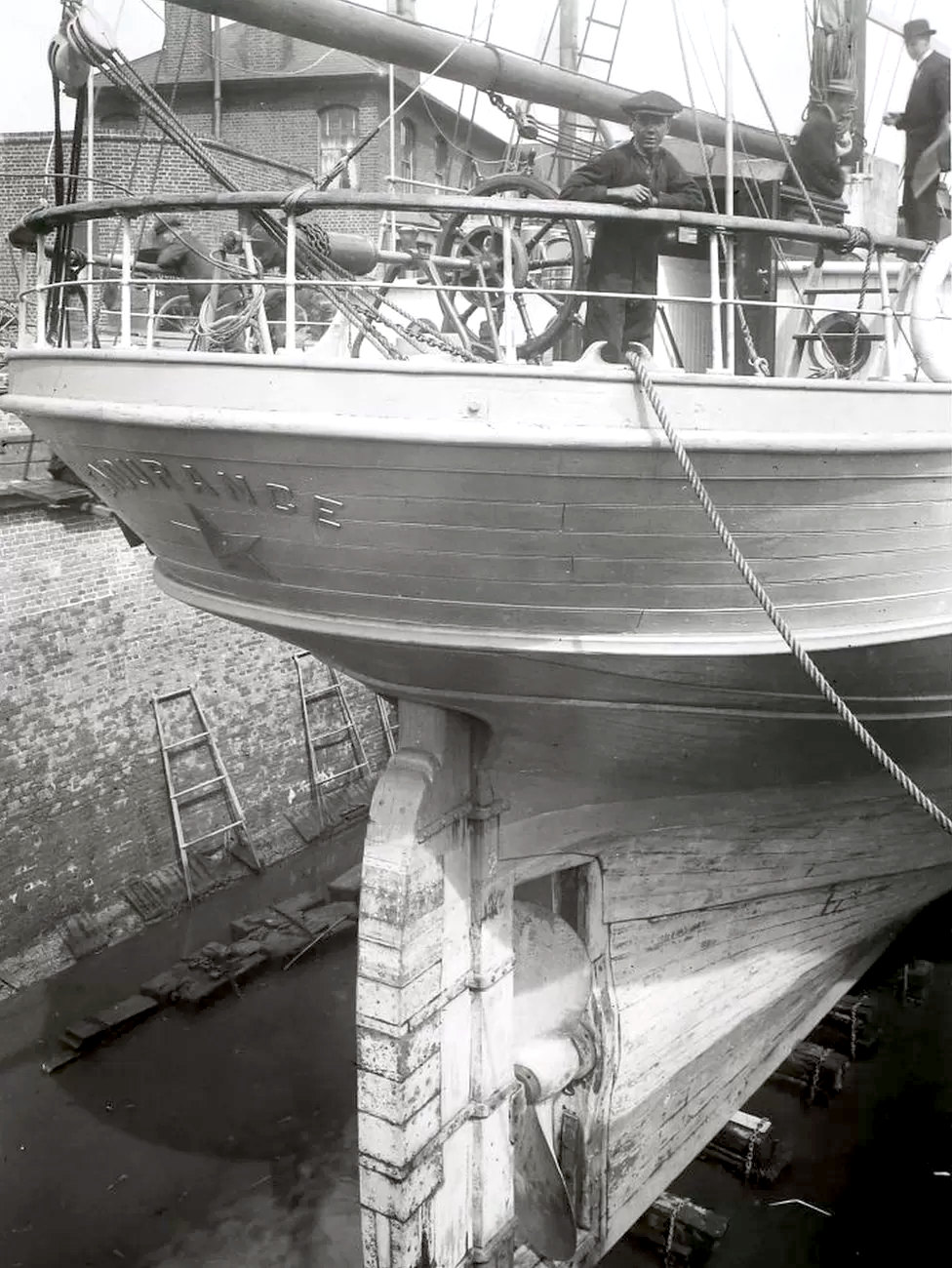
Sir
Ernest Shackleton's Endurance
Sir
Ernest Henry Shackleton CVO, RNR (February 15, 1874
– January 5, 1922) was an Anglo-Irish explorer, now
chiefly remembered for his Antarctic expedition of
1914–1916 in the ship Endurance.
After
Captain
Scott died during an attempt to reach the South Pole
in 1912, Shackleton (1874–1922) chose to tackle the
challenge of Antarctica in a different way. He decided
he would attempt to journey across the icy continent
from one side to the other via the South
Pole.
Shackleton was a romantic adventurer, who became
interested in exploration and joined the Royal
Geographical Society while still at sea. In 1901 he got
a place on Captain Scott's first Antarctic expedition,
in the Discovery, through his seafaring skills
and contact with one of the expedition sponsors.
In
1907, he led his own British Antarctic Expedition in the
Nimrod. Other members of the expedition climbed
Mount Erebus and reached the south magnetic pole. Using
ponies and also dragging his own sledges Shackleton
himself led a party which reached to only 97 miles from
the Pole. Although there had not been much government
support beforehand, Shackleton received a hero's welcome
when he returned. He was knighted, becoming Sir Ernest
Shackleton.
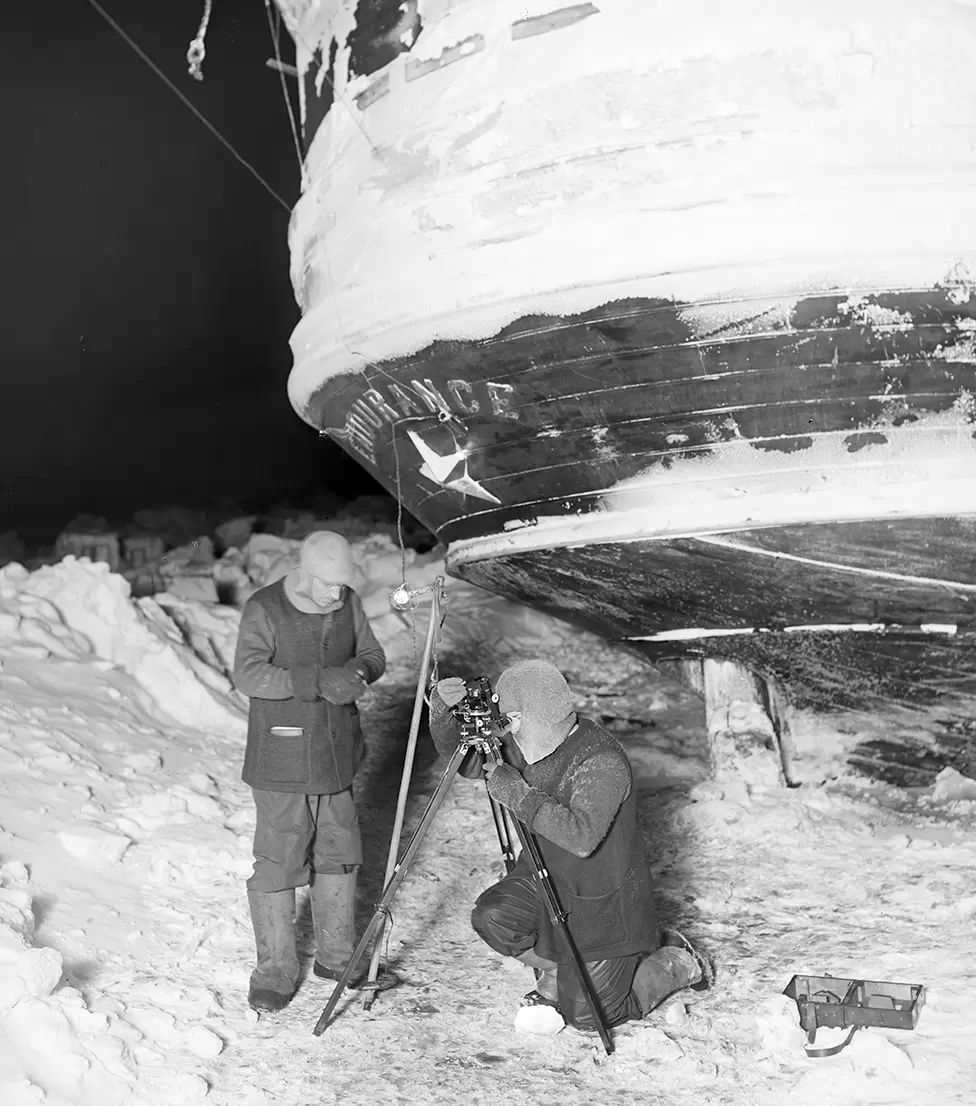
Stuck
in the ice, Antarctic surveyor Frank Worsley and Ernest Shackleton
ABOUT
ANTARCTICA
Antarctica is an enormous continent. More than 99% of it
is covered by ice. In places, this ice is more than
three miles thick. Antarctica is completely surrounded
by the vast Southern
Ocean, half of which freezes in
winter. It is high, windy and extremely cold. There is
no indigenous human population and no life forms at all
except around the coast
More
than 2000 years ago, Greek writers described a large
mass of land in the south of the world. Even though they
had never seen it, they believed it must exist so that
it could 'balance' the land they knew about in the
northern half of the world. They named this imagined
land 'Anti-Arkitos', meaning the 'opposite of the
Arctic'.
Did explorers before Shackleton try to reach the
Antarctic?
Yes. For instance, Captain Cook had tried to
find the great southern continent on his second Pacific
voyage of 1772–74. In 1912, an expedition led by
Captain Robert Falcon Scott had been narrowly beaten in
the race to be first to the South Pole by the Norwegian
explorer Roald Amundsen.
BIOGRAPHY
Shackleton
was born in Kilkee, County Clare, Ireland in 1874, and
served as a merchant marine officer. He went to school
at Dulwich College from 1887 to 1890. In 1904 he married
Emily Dorman. They had three children - Raymond, Cecily
and Edward (Eddie), born in 1911. Their marriage was
marred by numerous affairs on Ernest's part, most
notably his relationship with the American born actress
Rosalind Chetwynd (Rosa Lynd) which was begun in 1910
and continued on and off until his death in 1922.
ANTARCTIC
EXPEDITIONS
1901
National Antarctic Expedition
Shackleton
participated in the National Antarctic Expedition, which
was organized by the Royal Geographical Society in 1901,
and led by Robert Falcon Scott. This expedition is also
called the "Discovery Expedition", as its ship
was called Discovery. The expedition was the
first to penetrate the Ross Sea and reach the Ross Ice
Shelf. He may have placed what has become one of the
world's most famous advertisements in the Times of
London in December 1901: "Men wanted for
hazardous journey. Small wages. Bitter cold. Long months
of complete darkness. Constant danger. Safe return
doubtful. Honour and recognition in case of success."
(Some historians have claimed that this ad was placed,
although they do not all agree on when or which
newspaper, but no one has yet been able to locate the
original newspaper clipping.)
1902
attempt on the South Pole
Shackleton
with Scott and Dr Edward Wilson trekked south towards
the South Pole in 1902. The journey proceeded under
difficult conditions, partially the result of their own
inexperience with the Antarctic environment, poor
choices and preparation and the pervading assumption
that all obstacles could be overcome with personal
fortitude. They used dogs, but failed to understand how
to handle them. As with most of the early British
expeditions, food was foolishly in short supply; the
personnel on long treks were usually underfed by any
sensible measure and were essentially starving. Scott,
Wilson and Shackleton made their "furthest
south" of 82°17'S on December 31, 1902. They were
463 nautical miles (857 km) from the Pole. Shackleton
developed scurvy on the return trip and Dr. Wilson
suffered from snow blindness at intervals.
When
Morning relieved the expedition in early 1903,
Scott had Shackleton returned to England, though he had
nearly fully recovered. There is some suggestion that
Scott disliked Shackleton's popularity in the expedition
and used his health as an excuse to remove him; he was
Merchant Marine and Scott was Royal Navy - which was
also part of the contention with whether Albert Armitage
was to remain for the second winter. In part, Scott
exhibited unusual stamina and may not have recognized
differing abilities of others.
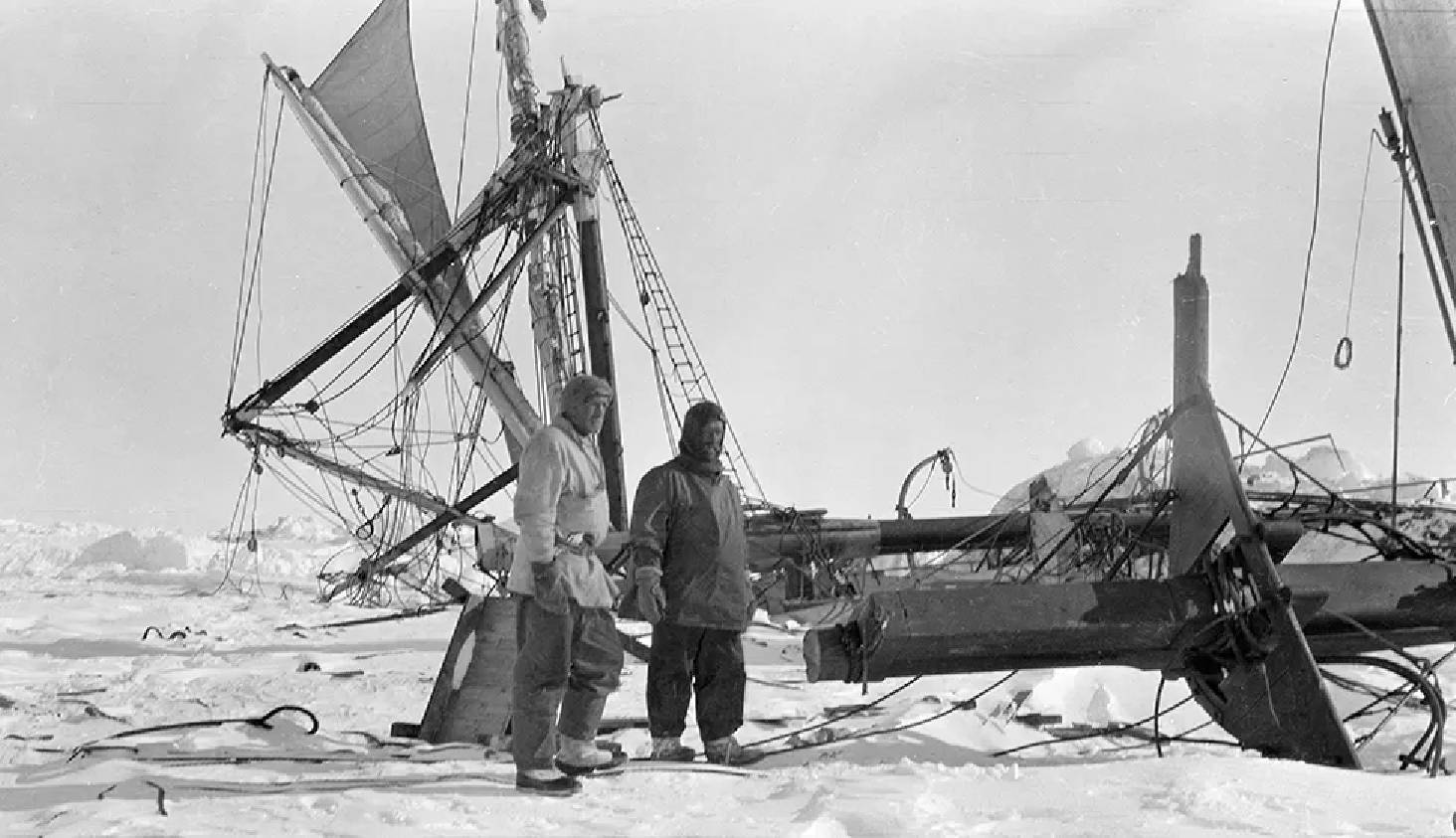
Endurance
being crushed by the ice, and sinking
1907–1909
British Antarctic Expedition
Shackleton
organized and led the "British Antarctic
Expedition" (1907–1909) to Antarctica. The
primary and stated goal was to reach the South Pole. The
expedition is also called the Nimrod Expedition after
its ship, and the "Farthest South" expedition.
Shackleton's base camp was built on Ross Island at Cape
Royds, approximately 20 miles (40 km) north of the
Scott's Hut of the 1901–1904 expedition; the hut built
at this camp in 1908 is on the list of the World
Monuments Watch's 100 most endangered sites.
Because of poor success with dogs during Scott's
1901–1904 expedition, Shackleton used Manchurian
ponies for transport, which did not prove successful.
Accomplishments
of the expedition included the first ascent of Mount
Erebus, the active volcano of Ross Island; the location
of the Magnetic South Pole by Douglas Mawson, Edgeworth
David and MacKay (January 16, 1909); and locating the
Beardmore Glacier passage. Shackleton, with Wild,
Marshall, and Adams, reached 88°23'S: a point only 180
km (97 nautical miles) from the South Pole. While the
expedition did not make it to the pole, nonetheless,
Shackleton, Adams, Marshall, and Wild were the first
humans to not only cross the Trans-Antarctic mountain
range, but also the first humans to set foot on the
South Polar Plateau.
Shackleton
returned to the United Kingdom a hero and was
immediately knighted. For three years he was able to
bask in the glory of being "the man who reached
furthest to the south." Of his failure to reach the
South Pole, Shackleton remarked: "Better a live
donkey than a dead lion." It should, however,
be pointed out that Shackleton and his group were
exceedingly fortunate to return from the Pole. They had
cut rations severely, such that there was no margin of
safety. They had very good weather throughout their
return, in contrast to Scott's experience three years
later.
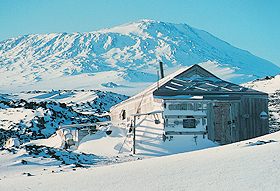
Ernest
Shackleton's hut Antarctica - endangered monument
Sir
Ernest Shackleton’s Expedition Hut - Cape Royds, Ross Island, Antarctica
Built in 1908, Sir Ernest Shackleton’s Hut at Cape
Royds is one of six wooden building ensembles remaining
on Earth’s southernmost continent from the heroic age
of Antarctic exploration. Used as an expedition base and
laboratory for scientific research, the building was
designed to withstand extreme weather conditions.
A century of Antarctic blizzards later, the hut is in
surprisingly good condition, but it has begun to suffer
the ravages of time and increased human visitation, and
is in need of urgent conservation. Shortly before the
site’s placement on WMF’s 2004 list of 100 Most
Endangered Sites, the New Zealand-based Antarctic
Heritage Trust had completed a comprehensive
conservation masterplan for the building and the
artifacts associated with it that includes measures
needed to maintain the site, which would take an
estimated five years and $3.8 million to implement.
Since listing, the hut has attracted increased media
visibility and has accrued grants totaling more than
$350,000 toward its preservation. Efforts to remediate
the immediate threat posed by decaying stores left
outside the hut were completed during the astral summer
2004–2005, while the development of methods to address
specific conservation problems at the site is well
underway. Far more must be done, however, before the
site is out of danger, which is why Shackleton’s Hut
remains on WMF’s 2006 Watch list. The need to increase
international support for preserving the hut is
underscored by the ambiguous legal status of the
explorers’ huts under the Antarctic Treaty and the
physical challenge of carrying out preservation work in
such an extreme environment.
1914–1916
Imperial Trans-Antarctic Expedition
The
Imperial Trans-Antarctic Expedition set out from
London on August 1, 1914 with the goal of crossing the
Antarctic from a location near Vahsel Bay on the south
side of the Weddell Sea, reach the South Pole and then
continue to Ross Island on the opposite side of the
continent. The expedition's goal had to be abandoned
when the ship, Endurance, was beset by sea ice
short of its goal of Vahsel Bay. It was later crushed by
the pack ice.
The
ship's crew and the expedition personnel endured an epic
journey by sledge across the Weddell Sea pack and then
boat to Elephant Island. Upon arrival at Elephant Island
off the Antarctic Peninsula, they rebuilt one of their
small boats and Shackleton with five others set sail for
South Georgia to seek help. This remarkable journey in
the 6.7-meter boat James Caird through the Drake
Passage to South Georgia in the late Antarctic Fall
(April and May) is perhaps without rival. They landed on
the southern coast of South Georgia and then crossed the
spine of the island in an equally remarkable 36-hour
journey. The 22 men who remained on Elephant Island were
rescued by the Chilean ship Yelcho after three
other failed attempts on August 30, 1916 (22 months
after departing from South Georgia). Everyone from Endurance
survived.
What
was Shackleton's most difficult journey of exploration?
In 1914, in command of a party in the ship Endurance,
Shackleton set off to cross the Antarctic from one side
to the other, from the Weddell Sea to the Ross Sea. As
both Amundsen and Scott had reached the South Pole and
the Americans had reached the North
Pole, he saw this as
the last great challenge.
Although the expedition failed because
Shackleton did not reach the South Pole, in other ways
it was his biggest success. He triumphed over enormous
difficulties to bring his men safely home after the Endurance
was trapped and crushed by ice in the Weddell Sea.
To do so, he made an incredible journey to get help.
Shackleton and his men set sail in August 1914, just as
war was starting in Europe. On 19 January 1915, Endurance
became locked in the ice of the Weddell
Sea. Over
the course of the next nine months the ship was
gradually crushed, finally sinking on 27 October. It
proved impossible for the 28 men to drag their boats and
stores across the frozen sea so Shackleton camped on the
ice and drifted with it. When the ice began to break up
as it drifted north into warmer waters, the men launched
the three boats and, in dangerous conditions, managed to
reach Elephant Island. This rocky and barren island was
still more than 800 miles from the nearest inhabited
land with people who could help them.
They were cold and exhausted, and weak from the
hardships of the journey. They knew they would not be
found and could not all sail further. They were also
worried that their supplies of food would not last long.
There were seals and penguins to kill for food and fuel
but not many and they eventually had to rely on
collecting shellfish.
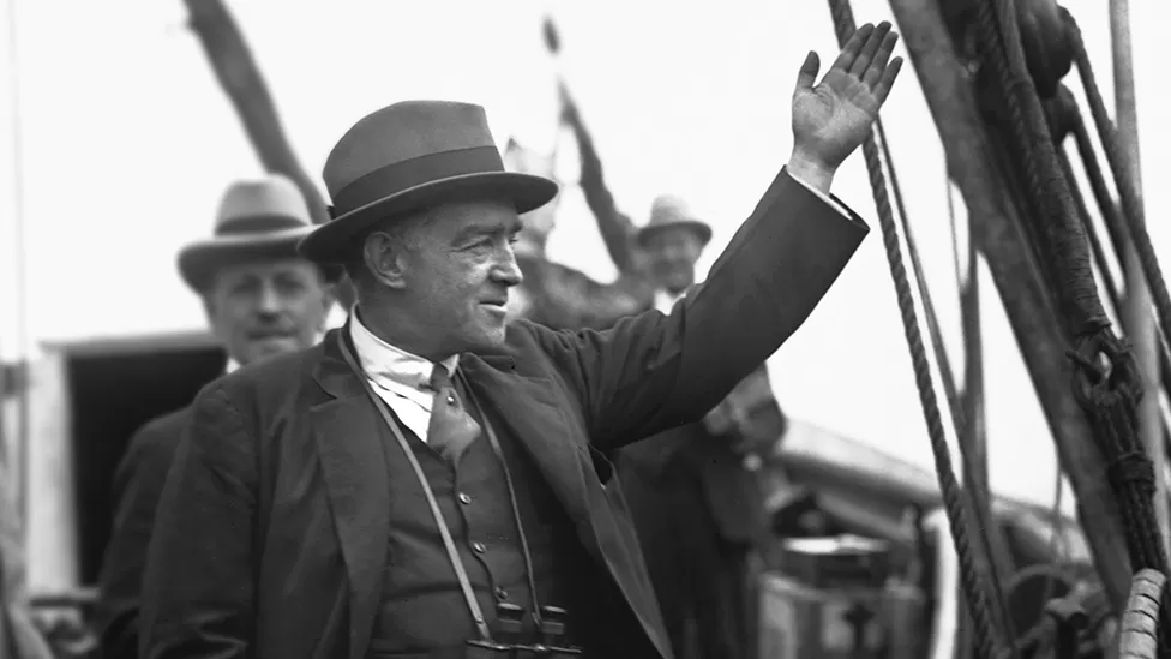
Sir Ernest Shackleton,
1874–1922
He decided to leave most of the party behind, while he
set out in a boat to reach South Georgia, the nearest
inhabited island, 800 miles away. He knew that he would
find help there, at the Norwegian whaling stations on
the north side.
No. He and five others left in the best of their ship's
boats, the James Caird. Although it was winter
and the Southern Ocean is the stormiest in the world,
they knew the plan was their best hope for the survival
of the whole party. When the six set sail, the rest of
the group were left behind to make camp on Elephant
Island. The James Caird was
just over 7 metres long and 2 metres wide.
Did
Shackleton make any changes to the boat before they set
sail?
Yes. The carpenter, 'Chippy' McNeish, made the bottom of
the boat stronger, and stretched a canvas deck over most
of it to give some shelter. The journey was extremely
dangerous. On many occasions, the six believed they were
about to sink in the terrifying conditions they
encountered, with waves which seemed as high as
mountains and violent storms. They were constantly wet
and cold and one of the biggest dangers they faced was
the weight of the ice collecting on the boat as the
sea-spray froze. Several times they risked their lives
hacking it off to prevent the boat capsizing. They also
had a real fear that their water would run out before
they made land. After 15 exhausting days at sea, they
finally sighted South Georgia.
They
found it very difficult to find a place to land their
boat safely, and were forced by gale, which nearly
wrecked them on the coast, to spend two more nights at
sea. Eventually, they managed to get into a cove in King
Haakon Bay on the south of the island. To their relief,
they found a stream with fresh water almost immediately.
They found a cliff
overhang where they could shelter and light a fire for
warmth.
Shackleton led, taking the tough seaman Tom
Crean and Frank Worsley, the expert navigator on the James
Caird, who also had mountaineering experience. The
journey involved a climb of nearly 3000 feet (914 metres).
They did not take a tent and could not rest for long
because they could easily freeze to death if they fell
asleep in the snow. Apart from short breaks they marched
continuously for 36 hours, covering some 40 miles over
mountainous and icy terrain.
They heard the steam-whistle of the Stromness
whaling station, signalling the start of another day's
work at 07.00. After scrambling down a final ridge, the
three men at last reached people who could help them.
They were all rescued. Those on Elephant Island had to
wait longer, until 30 August 1916, but were eventually
picked up by Shackleton on a Chilean navy tug. All the
men believed that their survival was due largely to his
tremendous leadership. Many would have believed it
impossible to bring all his men home with no lives lost.
Many of his men were to return immediately to the harsh
reality of the First World War. Tragically, after
surviving so many dangers with Shackleton, some were to
perish in it.
1921
Final expedition
In
1921, Shackleton set out on another Antarctic
expedition, but died of a heart attack on board his
ship, the Quest, while anchored off South Georgia Island
on January 5, 1922. His body was being returned to
England when his widow requested that the burial take
place on Grytviken, South Georgia Island instead.
Shackleton was buried there on March 5.
Nowadays,
the southern continent is shared between 27 nations that
have scientists based there. The things they study
include changes in climate and the destruction of the
ozone layer. For further information about the Antarctic
today visit the British
Antarctic Survey website.
Legacy
In
1994, the James Caird Society was set up to preserve the
memory of Shackleton's achievements. Its first Life
President was Shackleton's younger son, Edward
Shackleton.
Sir
Ernest Shackleton is the subject of Shackleton, a
two-part Channel 4 drama directed by Charles Sturridge
and starring Kenneth Branagh as the explorer. The same
story is related in greater detail in the book
Endurance: Shackleton's Incredible Voyage, by Alfred
Lansing.
Shackleton's
grave, near the former whaling station at Grytviken on
South Georgia is frequently visited by tourists from
passing cruise ships. The
British Antarctic Survey's logistics vessel RRS Ernest
Shackleton (the replacement for RRS Bransfield) is named
in his honour.
THE
ENDURANCE
The name 'Endurance' has been applied to two ships of the Royal Navy, inspired by the 1912 ship used by Sir Ernest
Shakleton.
1912 SHIP
The Endurance was the three-masted barquentine in which Sir Ernest Shackleton sailed for the Antarctic on the 1914 Imperial Trans-Antarctic Expedition. She was launched in 1912 from Sandefjord in Norway and was crushed by ice, causing her to sink, three years later in the Weddell Sea off Antarctica.
Design and construction
Designed by Aanderud Larsen, the Endurance was built at the Framnaes shipyard in Sandefjord, Norway and fully completed on December 17, 1912. She was built under the supervision of master wood shipbuilder Christian Jacobsen, who was renown for insisting that all men employed under him not just be skilled shipwrights, but also be experienced in seafaring aboard whaling or sealing ships. Every detail of her construction had been scrupulously planned to ensure maximum durability, for example every joint and every fitting cross-braced each other for maximum strength
She was launched on December 17, 1912 and was initially christened the Polaris (eponymous with Polaris, the North Star). She was 144 feet (43.9 m) long, with a 25 foot (7.6 m) beam and weighed 350 tons (356 metric tons). She was designed for polar conditions with a very sturdy construction, her sides were between 2 1/2 feet and 18 inches thick, with twice as many frames as normal and the frames being of double thickness. She was built of planks of oak and Norwegian fir up to two and one half feet thick, sheathed in greenheart, a notably strong and heavy wood. Her bow, where she would meet the ice head-on, had been given special attention. Each timber had been made from a single oak tree chosen for its shape so that is natural shape followed the curve of her design. When put together, these pieces had a thickness of 4 feet, 4 inches. Her keel members were four pieces of solid oak, one above the other, adding up to a thickness of 7 feet, 1 inch.
Of her three masts, the forward one was square-rigged, while the after two carried fore and aft sails, like a schooner. As well as sails, Endurance had a 350 hp (260 kW) coal-fired steam engine capable of driving her at speeds up to 10.2 knots (19 km/h).
By the time she was launched on December 17, 1912, Endurance was perhaps the strongest wooden ship ever built, with the possible exception of the Fram, the vessel used by Fridtjof Nansen and later by Roald Amundsen. However, there was one major difference between both ships. The Fram was bowl-bottomed, which meant that if the ice closed in against her she would be squeezed up and out and not be subject to the pressure of the ice compressing around her. But since the Endurance was designed to operate in relatively loose pack ice she was not constructed so as to rise out of pressure to any great extent.
Ownership
She was built for Adrien de Gerlache and Lars Christensen. They intended to use her for polar cruises for tourists to hunt polar bears. Financial problems leading to de Gerlache pulling out of their partnership meant that Christensen was happy to sell the boat to Ernest Shackleton for GB£11,600 (approx US$67,000), less than cost. He is reported to have said he was happy to take the loss in order to further the plans of an explorer of Shackleton's stature. After Shackleton's purchase the ship was
re-christened Endurance after the Shackleton family motto "Fortitudine vincimus" (By endurance we conquer).
Final voyage
Shackleton sailed with Endurance from Plymouth, England on August 6, 1914 and set course for Buenos Aires, Argentina. This was Endurance's first major cruising since her completion and amounted to a shakedown cruise. The trip across the Atlantic took more than two months. Built for the ice, her hull was considered by many of its crew too rounded for the open ocean. On October 26, 1914 Endurance sailed from Buenos Aires to her last port of call, the Grytviken whaling station on the island of South Georgia off the southern tip of South America, where she arrived on November 5. She departed from Grytviken for her final voyage on December 5, 1914 towards the southern regions of the Weddell Sea.
The 25 man crew (and one stow away) were headed for Antarctica. The goal was to land on one side of Antarctica and send a 6 man dog sled team 3,000 kilometers across the continent to be the first to make a cross continental journey. As they journeyed South they joked with the young stowaway that if anything should happen he would be eaten first since there were no edible plants in Antarctica and only penguins, seals & walrus's during the summer.
Two days after leaving from South Georgia, Endurance encountered polar pack ice and progress slowed down. For weeks Endurance twisted and squirmed her way through the pack. Though slow, she kept moving but averaged less than 30 miles per day. By January 15, Endurance was within 200 miles of its destination, Vahsel Bay. However by the following day heavy pack ice was sighted in the morning and in the afternoon a blowing gale developed. Under these conditions it was soon evident progress could not be made, and Endurance took shelter under the lee of a large grounded berg. During the next two days Endurance dogged back and forth under the sheltering protection of the berg.
On January 18 the gale began to moderate and thus Endurance, one day short of her destination, set the topsail with the engine at slow. The pack had blown away. Progress was made slowly until hours later Endurance encountered the pack once more. It was decided to move forward and work through the pack, and at 5pm Endurance entered it. However it was noticed that this ice was different from what had been encountered before. The ship was soon engulfed by thick but soft ice floes. The ship floated in a soupy sea of mushy brash ice. The ship was beset. The gale now increased its intensity and kept blowing for another six days from a northerly direction towards land. By January 24, the wind had completely compressed the ice in the whole Weddell Sea against the land. The ice had packed snugly around Endurance. All that could be done was to wait for a southerly gale that would start pushing, decompressing and opening the ice in the other direction. Instead the days passed and the pack remained unchanged.
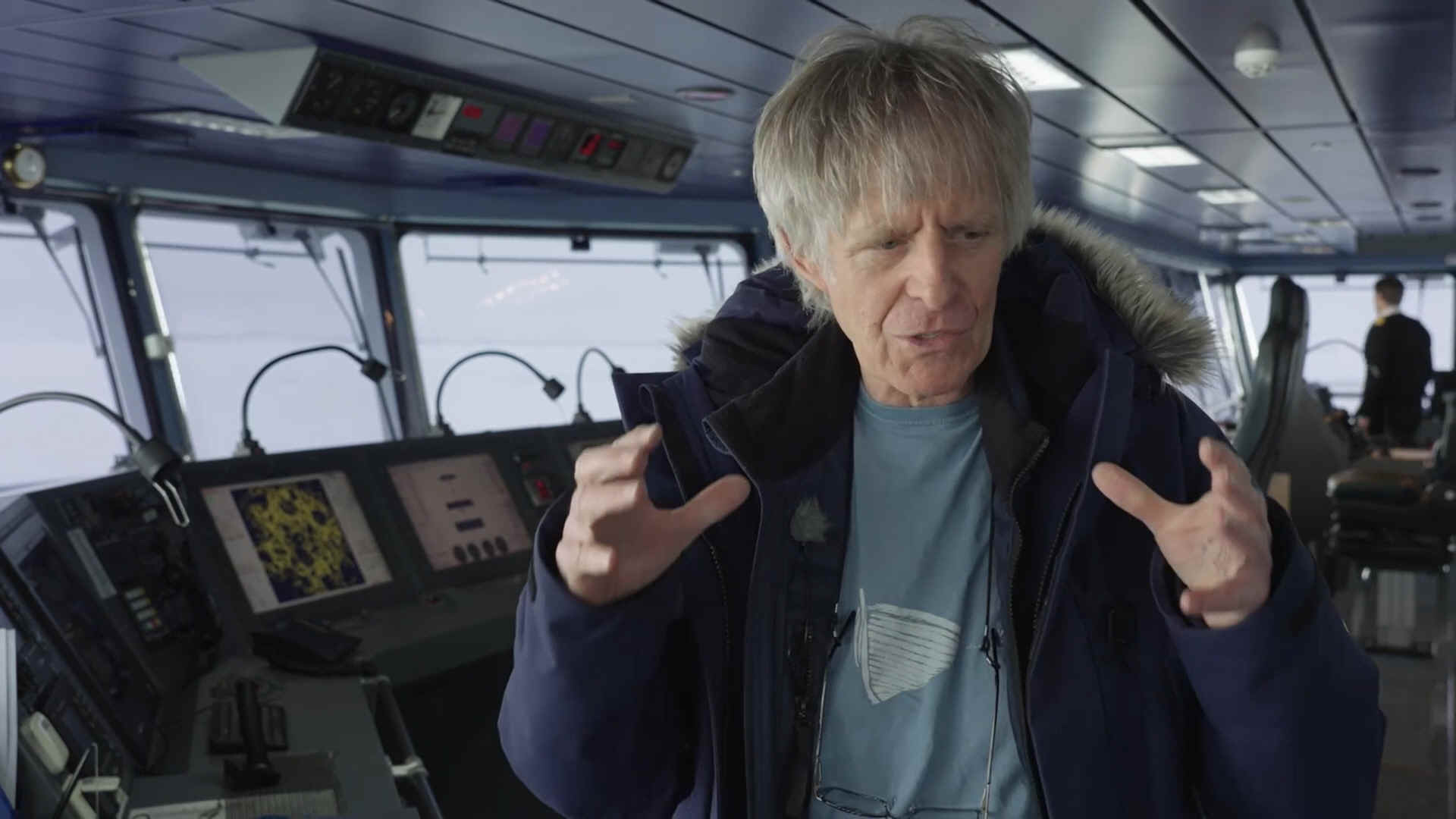
REDISCOVERY
OF ENDURANCE
BBC NEWS 9 MARCH -
ENDURANCE: 'FINEST WOODN SHIPWRECK I'VE EVER SEEN'
Endurance, the lost ship of Anglo-Irish explorer Sir Ernest Shackleton, has finally been identified on the floor of Antarctica's Weddell Sea. The vessel was crushed by sea-ice and sank on 21 November 1915, forcing Shackleton and his men to make a heroic escape on foot and in small boats.
Marine archaeologist Mensun Bound described the condition of Endurance to the BBC.
"Without any exaggeration this is the finest wooden shipwreck I have ever seen - by far.
It is upright, well proud of the seabed, intact, and in a brilliant state of preservation.
You can even see the ship's name - E N D U R A N C E - arced across its stern directly below the taffrail (a hand rail near the stern). And beneath, as bold as brass, is Polaris, the five-pointed star, after which the ship was originally named.
I tell you, you would have to be made of stone not to feel a bit squishy at the sight of that star and the name above.
And just under the tuck of the stern, laying in the silt is the source of all their troubles, the rudder itself. You will remember that it was when the rudder was torn to one side by the ice that the water came pouring in and it was game-over. It just sends shivers up your spine.
When you rise up over the stern, there is another surprise. There, in the well deck, is the ship's wheel with all its spokes showing, absolutely intact. And before it is the companionway (with the two leaves of its door wide open) leading down to the cabin deck. The famous Frank Hurley (expedition photographer) picture of Thomas Ord Lees (motor expert) about to go down into the ship was taken right there.
And beside the companion way, you can see a porthole that is Shackleton's cabin. At that moment, you really do feel the breath of the great man upon the back of your neck.
The funnel is still there, but not upright, lying semi-thwartships (almost at a right-angle to the keel), still with its steam whistle attached. Beside it is the engine room skylight. We could look down through it. I was hoping to see the cylinder heads of its triple-steam expansion engines, but couldn't quite make them out.
Near midships there is a boot, with another one, maybe its pair, in the debris field beside the wreck; also several plates and a cup.
When the mast fell, it crushed the ward room with the bridge deck above, but you can see the outline of the wardroom and beside it the galley and pantry. One wall of the galley is still standing with its two forward portholes intact.
On the weather deck, you can see the forward hold and skylight with the fo'c'sle deck (the upper-deck forward of the foremast) just beyond.
The fo'c'sle deck is damaged, for although the vessel went down keel first, she was down slightly at the bow so it was that part of the hull that first struck the seabed and so took the shock of impact.
The capstan is still visible on the fo'c'sle deck and beside it is one of the anchors. The other anchor broke free; it snakes out over the seabed.
The bow looks amazing. You can see its forward raking stem and the metal-shod cutwater that cleaved the ice.
The masts, spars, booms and gaffs are all down, just as in the final pictures of her taken by Frank Hurley. You can see the breaks in the masts just as in the photos. There is a tangle of ropes, blocks and deadeyes.
You can even see the holes that Shackleton's men cut in the decks to get through to the 'tween decks to salvage supplies, etc, using boat hooks. In particular, there was the hole they cut through the deck in order to get into "The Billabong", the cabin in "The Ritz" that had been used by Hurley, Leonard Hussey (meteorologist), James McIlroy (surgeon) and Alexander Macklin (surgeon), but which was used to store food supplies at the time the ship went down.
I had been hoping to find Orde Lees' bicycle, but that wasn't visible, nor were there any of the honey jars that Robert Clark (biologist) used to preserve his samples that I also hoped I might find.
The depth is 3,008m (9,868ft).
Endurance was found just over four nautical miles (7.5km) and roughly southward of Frank Worsley's famous sinking position (68°39'30" South; 52°26'30" West).
We found the wreck a hundred years to the day after Shackleton's funeral (5 March 1922). I don't usually go with this sort of stuff at all, but this one I found a bit spooky."

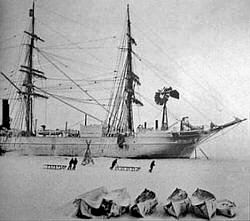
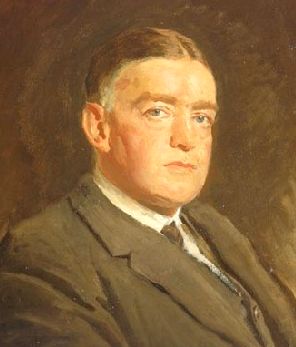
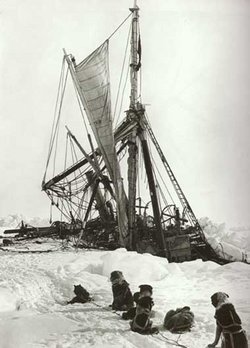
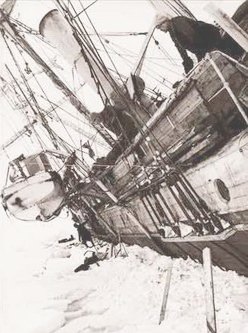
Sir
Ernest Shackleton and Endurance
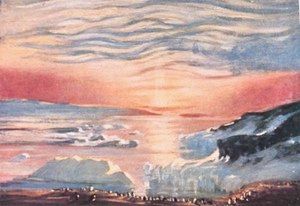
Sunset
In: "The Heart of the Antarctic" Volume I
by Shackleton 1909
https://www.bbc.co.uk/news/science-environment-60654016
RETURN
TO BASECAMP
OR EXPLORE OUR
PREHISTORIC A-Z
|











